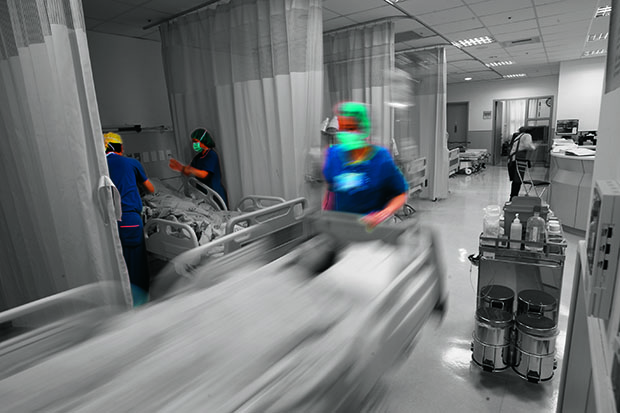Taiwan's Health Care Crisis
Queuing for Emergency Rooms

Source:CW
When hundreds of burn victims were recently rushed to emergency rooms after a fire catastrophe at a seaside water park, the problem of Taiwan's overcrowded emergency rooms came to the fore.
Views
Queuing for Emergency Rooms
By Whitney HuangFrom CommonWealth Magazine (vol. 576 )
"We were really lucky that night!" exclaims Chou Tzung-hsin, attending physician at the Department of Emergency Medicine at National Taiwan University Hospital. Chou was on duty when the victims from the inferno at the Formosa Fun Coast water park were brought in on June 27.
On that day, the emergency department was crowded as usual with more than 150 patients under observation. These numbers were only 80 to 90 percent of what the hospital sees at peak times.
Had the disaster occurred several days earlier, not only would the hallways outside the emergency room been crowded, the security guard area at the hospital entrance have been lined with patients on gurneys as well. Chou shudders to think what would have happened if dozens of severely burnt victims had arrived amid such a backup of waiting patients. It would have hardly been possible to divert patients to other departments or other hospitals in time to make space for the huge number of burn victims in need of immediate medical attention.
It is not news that the emergency rooms of medical centers, whose task is to provide emergency medical treatment, are often as crowded as the island's traditional markets. In the event of a major disaster or mass accident, they can be pushed beyond their capacity to respond.
"To be honest, the vast majority of medical centers near the Danshui area, such as Taipei Veterans General Hospital, MacKay Memorial Hospital, Shin Kong Wu Ho-Su Memorial Hospital and Cheng Hsin General Hospital, have been running at full or over capacity for a long time. How could they have space to treat a large number of critically injured people? The problems of emergency room overcrowding, personnel shortages and the misuse of emergency resources are brought up every time a major accident happens. Why?" asked the Taiwan Medical Alliance for Labor Justice and Patient Safety (TMAL) indignantly after the fire disaster. TMAL is a professional association for healthcare personnel.
At the overcrowded emergency departments, the quality of medical care already suffers at times even without disasters.
A survey published by the Taiwan Healthcare Reform Foundation found that, annually, nearly 3,800 patients classified as level 1 patients (life-threatening condition, requiring immediate resuscitation, medical emergency) were boarded in the emergency room for more than two days before being transferred to an inpatient unit. The more critical the patients' condition was, the longer they were held in the emergency department, according to the survey.
On the average, three out of ten critically ill patients or patients who need resuscitation cannot be transferred to the intensive care unit within six hours of their arrival at the emergency department. Foreign academic research points out that an emergency physician should see an average of 2.3 patients per hour, and nurse practitioners should care for a maximum of four patients, or else the quality of care will be compromised.
But Taiwan's emergency medicine personnel shoulder a workload that is several times heavier than recommended abroad.
Take Chou as an example. He usually works 12-hour shifts from 8 p.m. to 8 a.m. the next day. Within this 12-hour shift, Chou will likely have to attend to some 70 patients, which works out to an average of 5.8 patients per hour. This is 2.5 times the number of patients recommended in the research study.
"If there are too many patients, this will affect the treatment of medical emergencies," explains Chou. He gets annoyed when relatives of non-critically injured patients interrupt him as he is attending to elderly people with critical respiratory or heart problems.
Unbalanced Reimbursements
The National Health Insurance (NHI) system has a lot to do with hospital crowding. Due to the current policy, grassroots medical care facilities and local hospitals are not able to fully develop their first line emergency care capabilities.
In an interview with CommonWealth Magazine, Chang Chih-hua, attending physician at the emergency department of Shin Kong Wu Ho-Su Memorial Hospital, once pointed out that there is a correlation between hospital rating and the payments that the NHI makes to medical institutions for their services. The point value of NHI payments for emergency care at local hospitals stands at 0.7 or 0.8, whereas it can reach 1.0 at the highest-ranked medical centers.
As a result, resources are focused on the medical centers. In contrast, emergency care at small hospitals incurs greater losses the more patients are treated. Given personnel shortages and inadequate equipment, which increases the risk of medical disputes, it is only natural that smaller hospitals are not keen on getting involved in first-line emergency care. "The emergency rooms at local hospitals are mostly empty. People go there once and will then be scared to go back," remarks Chang.
On top of that, the patient registration fee for emergency departments at medical centers stands at only NT$700, an amount that is often too small to deter non-emergency patients from seeking medical attention at the emergency room, putting a strain on limited emergency resources.
Due to this vicious cycle, the emergency rooms of medical centers become overcrowded more easily.
Furthermore, some hospitals let patients continue to stay in the emergency room, increasing the already heavy work load of emergency doctors and nurses, as a result of the NHI's inpatient bed transfer system.
A veteran doctor who prefers to remain anonymous once told our reporter that inpatient beds are often allocated based on whether the respective ward will make or lose money from NHI-covered beds. "The more a specialist ward loses, the fewer NHI-covered beds it will have," the physician said.
Easily operating in the red are the departments of infectious diseases, nephrology, thoracic surgery or neurology, where few patients have to pay their treatment out of their own pockets, courses of treatment are long, and hospital stays also tend to be long. As a result, they get allocated only a small number of NHI-covered beds.
In contrast, emergency room patients are more easily admitted to inpatients units in orthopedics, neurosurgery and cardiology because many medical supplies and devices there are not covered by the NHI.
"Those who lie in the emergency room are patients [from medical specialties] that won't let the hospital make money!" the doctor said.
Emergency room work is very stressful, but doctors complain that the NHI does not provide sufficient incentives to encourage hospitals to develop their emergency departments and increase emergency room personnel.
"The NHI does not really devote a lot of resources to emergency care," remarks Chen Jih-chang, president of the Taiwan Academy of Emergency Department Management (TAEM) and head of the Department of Emergency Medicine at Linkou Chang Gung Memorial Hospital.
He cites an example: The NHI pays a 20-percent higher diagnosis fee to emergency room physicians on weekends, national holidays and during night shifts. However, if the Chang Gung Memorial Hospital wants to retain its doctors and nurses, "it pays multiple times the regular diagnosis fee" on such occasions.
Moreover, the NHI pays based on patient volume. Yet 80 percent of emergency room patients come in during the day, whereas only 20 percent are admitted during the night or on weekends and national holidays. The hospitals' costs remain high even at night or on holidays when there are fewer patients because they still need to keep sufficient medical personnel on duty.
"When hospitals maintain 24-hour emergency care, their costs are two or three times higher (than NHI reimbursements). Why should the hospitals raise quality if the NHI payments are not enough?" asks Chen.
Overworked, Underpaid Physicians
Rumors are circulating that some hospitals are lobbying the Ministry of Health and Welfare to lower regulatory staffing level standards because they are not able to meet the standards stipulated by the Emergency Medicine Capacity Grading and Evaluation system. These hospitals are also said to be pushing for an extended validity period following a successful evaluation.
 Taiwan’s emergency medicine personnel shoulder a workload that is several times heavier than abroad.
Taiwan’s emergency medicine personnel shoulder a workload that is several times heavier than abroad.
"One role of emergency care is to save the lives of patients in life-threatening conditions. Therefore, standards should be raised. How could we lower them instead? We will not necessarily experience disasters all the time, but we need to invest during ordinary times to lay the foundations in the long run," says Chen.
Lowering staffing level standards would only aggravate the work conditions in already understaffed emergency rooms. Nurses and doctors who suffer under their current work load would become even more overworked and lose their morale. As a result, hospitals would find it even more difficult to retain emergency medicine personnel.
"Many residents are not able to make it through the first year," reveals resident physician Cheng Yong-chang, who is about to start his second year at the emergency department of Taipei Hospital, which is directly under the jurisdiction of the Ministry of Health and Welfare.
Another doctor who was recently promoted to emergency medicine attending physician notes that he began his residency together with seven colleagues. At the end of the first year, three residents left. "If you are always that exhausted [from work], everyone wants to leave," the physician notes, not trying to hide his frustration.
The deficiencies in the emergency medicine system must be addressed immediately. "The overcrowding in emergency rooms in Taiwanese hospitals actually reflects the collapse of the National Health Insurance system. We cannot allow the government to ignore this," TMAL warned in a five-point appeal in early June.
Good Capacity, Bad Management
Chen suggests that doctors make greater use of referrals. "Island-wide there are enough hospital beds, the problem is their allocation (uneven use)," says Chen.
Presently, the Ministry of Health and Welfare encourages the implementation of a hospital transfer policy. However, first-line emergency medicine personnel point out that a patient only needs to say "I don't want a transfer" to thwart efforts to ease overcrowding by transferring patients to other hospitals.
However, Chen opposes a proposal by the Ministry of Health and Welfare requiring medical centers to bring down to zero the ratio of patients who are still boarded in the emergency room 48 hours after their admission. Should a medical center fail to achieve this zero ratio, it would lose its "medical center" status and be downgraded to a "regional hospital."
"The symptoms are manifested here (in the medical center), but the root illness does not lie with us," remarks Chen in elaborating on the reasons for his rejection of the Ministry's plans.
He suggests that the Ministry and the NHI Administration establish an online bed management system that links hospitals with overcrowded emergency departments with other hospitals. The NHI would be tasked with finding inpatient beds for admitted patients in emergency rooms. Should a patient refuse transfer to another hospital, he or she would have to sign a statement issued by the Ministry and the NHI Administration so that the hospital does not have to take all the blame.
It will definitely take more radical reforms before Taiwan's emergency medical system can achieve maximum effectiveness with its finite resources.
Translated from the Chinese by Susanne Ganz






